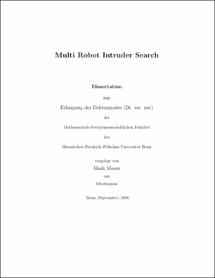Moors, Mark: Multi Robot Intruder Search. - Bonn, 2009. - Dissertation, Rheinische Friedrich-Wilhelms-Universität Bonn.
Online-Ausgabe in bonndoc: https://nbn-resolving.org/urn:nbn:de:hbz:5N-16493
Online-Ausgabe in bonndoc: https://nbn-resolving.org/urn:nbn:de:hbz:5N-16493
@phdthesis{handle:20.500.11811/4019,
urn: https://nbn-resolving.org/urn:nbn:de:hbz:5N-16493,
author = {{Mark Moors}},
title = {Multi Robot Intruder Search},
school = {Rheinische Friedrich-Wilhelms-Universität Bonn},
year = 2009,
month = feb,
note = {The aim of this work is the development and analysis of methods and algorithms to allow a multi robot system to cooperatively search a closed, 2-dimensional environment for a human intruder. The underlying problem corresponds to the game-theoretic concept of a classical pursuit evasion game, whereas the focus is set to the generation of plans for the group of pursuers.
While the main aspect of of this work lies in the field of probabilistic robotics, concepts and ideas are incorporated from differential game theory, algorithmic geometry and graph theory. The probabilistic basis allows the integration of sensor error as well as nondeterministic robot motion. The main contributions of this work can be divided into three major parts:
The first part deals with the development and implementation of probabilistic human models. Depending on the specific behavior of an intruder, ranging from uncooperative to unaware, different classes of intruders are identified. Models are proposed for two of these classes. For the case of a clever and uncooperative intruder who actively evades detection, we propose a model based on the concept of contamination. The second class corresponds to a person who is unaware of the pursuit. We show that simple Markov models, which are often proposed in literature, are not suited for modeling realistic human motion and develop advanced Markov models, which conform to random waypoint motion models.
The second part, which is also the most extensive part of this work, deals with the problem of finding an uncooperative and clever intruder. A solution is presented, which projects the problem on a graph structure, which is then searched by a highly optimized A* planner. The solution for the corresponding graph problem is afterwards projected back to the original search space and can be executed by the robotic pursuers. By means of the models proposed in the first part, the performance and correctness of the method is shown. We present experiments in simulation as on real robots to show the practicability and efficiency of the method.
The third part deals with the problem of finding an intruder who is unaware of the search. Based on the advanced Markov model previously discussed, a greedy algorithm is proposed, which aims at maximizing the probability to find the intruder in the near future. Experimental results for this method are shown and comparisons to simpler methods are given.},
url = {https://hdl.handle.net/20.500.11811/4019}
}
urn: https://nbn-resolving.org/urn:nbn:de:hbz:5N-16493,
author = {{Mark Moors}},
title = {Multi Robot Intruder Search},
school = {Rheinische Friedrich-Wilhelms-Universität Bonn},
year = 2009,
month = feb,
note = {The aim of this work is the development and analysis of methods and algorithms to allow a multi robot system to cooperatively search a closed, 2-dimensional environment for a human intruder. The underlying problem corresponds to the game-theoretic concept of a classical pursuit evasion game, whereas the focus is set to the generation of plans for the group of pursuers.
While the main aspect of of this work lies in the field of probabilistic robotics, concepts and ideas are incorporated from differential game theory, algorithmic geometry and graph theory. The probabilistic basis allows the integration of sensor error as well as nondeterministic robot motion. The main contributions of this work can be divided into three major parts:
The first part deals with the development and implementation of probabilistic human models. Depending on the specific behavior of an intruder, ranging from uncooperative to unaware, different classes of intruders are identified. Models are proposed for two of these classes. For the case of a clever and uncooperative intruder who actively evades detection, we propose a model based on the concept of contamination. The second class corresponds to a person who is unaware of the pursuit. We show that simple Markov models, which are often proposed in literature, are not suited for modeling realistic human motion and develop advanced Markov models, which conform to random waypoint motion models.
The second part, which is also the most extensive part of this work, deals with the problem of finding an uncooperative and clever intruder. A solution is presented, which projects the problem on a graph structure, which is then searched by a highly optimized A* planner. The solution for the corresponding graph problem is afterwards projected back to the original search space and can be executed by the robotic pursuers. By means of the models proposed in the first part, the performance and correctness of the method is shown. We present experiments in simulation as on real robots to show the practicability and efficiency of the method.
The third part deals with the problem of finding an intruder who is unaware of the search. Based on the advanced Markov model previously discussed, a greedy algorithm is proposed, which aims at maximizing the probability to find the intruder in the near future. Experimental results for this method are shown and comparisons to simpler methods are given.},
url = {https://hdl.handle.net/20.500.11811/4019}
}






